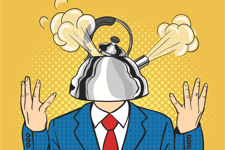
(I posted this first in October 2020 before the election. It seems right to repost it after the events of this week.) Anger is an emotion that arises when our left-brain determines that it has lost control of the situation. Iain McGilchrist, in The Master and His Emissary, offers evidence that anger, somewhat unique among emotions, is associated only with this hemisphere. In his divided-brain model, control and manipulation are the primary functions of this hemisphere. The left-brain is also the seat of power, both in the sense of dominating others and empowering success in consensual acts. Because anger and control or power-seeking are linked, the way that anger shows up signals what is happening in the brain, or, alternatively, to the state of mind (to use the metaphor of “mind”).
Persistent anger, then, is a sign of impotence, the inability to be in control—to be powerless. Unlike momentary emotional expressions of anger, persistent anger is a mood or attunement to the world. It is the context out of which other actions and reactions tend to arise. Cognitively, anger effectively shuts off contact with the world by isolating the right brain and its connections to that world, and locks the actor in a box where the only “facts” come from previously abstracted experiences, contextually unconnected with the immediate situation. This locking-out includes “facts” offered by others, directly or in written documents, books, media, etc. Persistently angry people, essentially, live in their own worlds, and, driven by the left-brain, generally act to force the real world to fit what is already in their brains. So far, everything I have written can the found or surmised in the work of McGilchrist.
I was originally motivated to write this after the first Presidential debate, because I saw that Trump’s angry mood prevented him from being in the situation. He insistently demanded control, obvious in almost every gesture and word. But as I wrote, it became clear that his angry mood explains much more about his lack of normalcy, in general. Fake news or alternate facts are a feature of this mood. Trump is cognitively unable, in this mood, to connect to the real world. His brain will substitute its own facts for what the right brain is “seeing.”
His constant muttering, during the debate and other venues, of “wrong” when the other is speaking is not simply bad manners; it is the left-brain in action. This mood also explains his abnormal attention only to media that echo or reinforce his expressed world and his labeling all other sources of input as “fake news.” It is much more than a political trick; it is an inevitable outcome of the mood. It is also why science and scientists and their facts are so often dissed.
The obverse of the cognitive coin is that persistent anger, as I note above, shuts out the right side, the seat of connections to the real world, in general, and to empathy in particular. The denial of the danger of Covid early on, which we know was Trump’s response, fits clearly into this consequence. It was so obviously uncontrollable that the response had to be to make it disappear in fact or in appearance. Anger prevents actions that reflect reality. Trump has had to recant what he said on occasions when the political reality manages to get through the fog of anger. The hyper-partisan way Trump has “governed” fits his way of connecting only to what he believes he controls—his base. As long as he continues to be angry, he is incapable of being the President for all of us. This mood trumps (sic) any hope for behavior that reflects all the facts.
I am not trying to figure out why he is the way he is. This analysis is based only on what we see, not on any reference to his previous life and to why he is what he is. I leave that to others.